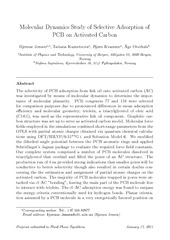Molecular Dynamics Study of Selective Adsorption of PCB on Activated Carbon
Journal article
Submitted version
Permanent lenke
https://hdl.handle.net/1956/5128Utgivelsesdato
2011Metadata
Vis full innførselSamlinger
Originalversjon
Fluid Phase Equilibria. 2011, 307 (1), 58-65. https://doi.org/10.1016/j.fluid.2011.05.001Sammendrag
The selectivity of PCB adsorption from fish oil onto activated carbon (AC) was investigated by means of molecular dynamics to determine the importance of molecular planarity. PCB congeners 77 and 118 were selected for comparison purposes due to pronounced differences in mean adsorption efficiency and molecular geometry; triolein, a triacylglycerol of oleic acid (C18:1), was used as the representative fish oil component. Graphitic carbon structure was set up to serve as activated carbon model. Molecular force fields employed in the simulations combined short-range parameters from the OPLS with partial atomic charges obtained via quantum chemical calculations using DFT/B3LYP/6-31**G+ and Solvation Model 6. We modified the dihedral angle potential between the PCB aromatic rings and applied Schr¨odinger’s Jaguar package to evaluate the required force field constants. Our complete system comprised a number of PCB molecules dissolved in triacylglycerol that overlaid and filled the pores of an AC structure. The production run of 4 ns provided strong indications that smaller pores will be conductive to better selectivity though also resulted in certain doubts concerning the the estimation and assignment of partial atomic charges on the activated carbon. The majority of PCB molecules trapped in pores were attached via cl–AC ”bonding”, leaving the main part of the PCB molecule free to interact with triolein. The cl–AC adsorption energy was found to surpass the energy criteria conventionally used for hydrogen bonds. Planar orientation assumed by a PCB molecule in a very energetically favored position on top of the graphite sheet clearly supported the π-cloud overlap hypothesis.
